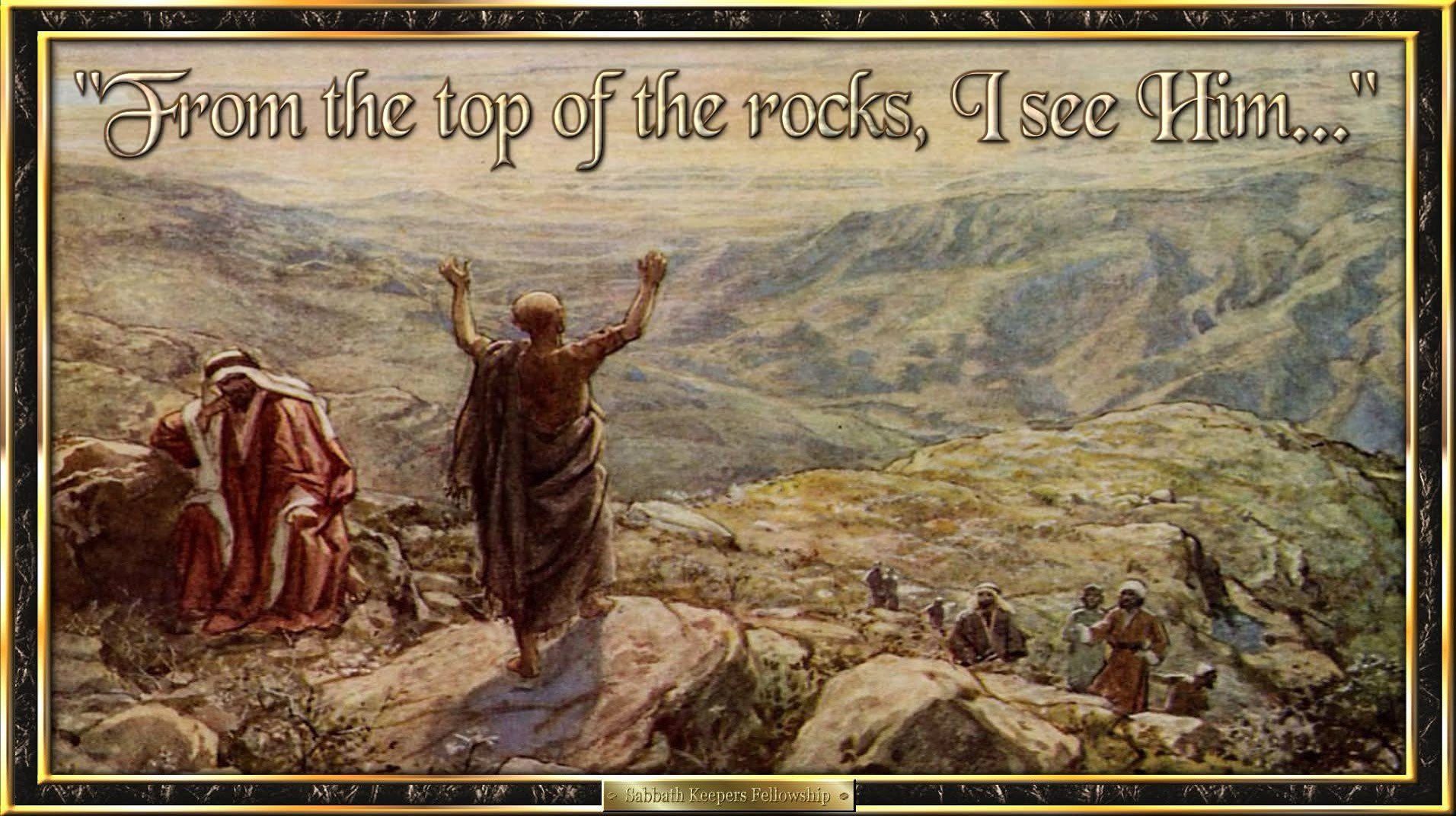Watch
Events
Articles
Market
More
THE COMPLETE BELIEVER’S CALENDAR PAGE FOR 7/2025
You are welcome to view or download a free PDF copy on Sabbath Keepers Fellowships’ website, or make a $15 donation to have the glossy full color paper version delivered to your door.
Our calendar is still the most accurate New Moon calendar on the planet after 25 years in production. It has New Moon predictions, festival and fast dates, Torah portion readings, and an explanation of each observance listed on it to learn from. This year’s theme is the name of Messiah, with quotes from the Sermon on the Mount. We even made the back-page ready for framing at years end, if you wish.
One thing different than other calendars of its type, besides the fact that we use more data in our predictions than others, is that each month, for those who subscribe, an email verification is sent out to verify the sighting of the New Moon by two or more witnesses in Israel. If weather prevents a predicted sighting, we will tell you and provide a PDF copy of that month’s corrected calendar. You’ll never go wrong with the CBC.
Each donation for a copy is used solely for the purpose of supporting our prison ministry efforts, so you’re giving to charity, as well. For each calendar you buy, two more are sent out to prisoners of our faith across the country. So, please order yours today before supplies are gone. And again, if you can’t afford $15, there’s a free copy for you on our website at:
https://sabbathkeepersfellowship.org/calendar




FROM THIS WEEK’S TORAH PORTION – BALAQ:
The Prophecies of Bila’am:
“From the top of the rocks I see him, and from the hills I observe him. Look, a people dwelling alone, not reckoning itself among the nations.”
“And YHWH put a word in the mouth of Bil’am, and said, ‘Return to Balaq, and this is what you say.’ And he returned to him and saw him standing by his ascending offering, he and all the heads of Mo’av. And he took up his proverb and said, ‘Balaq the king of Mo’av has brought me from Aram, from the mountains of the east. Come, curse Ya’aqov for me, and come, rage at Yisra’el! How do I curse whom Ěl has not cursed? And how do I rage at whom YHWH has not raged? For from the top of the rocks I see him, and from the hills I observe him. Look, a people dwelling alone, not reckoning itself among the nations. Who shall count the dust of Ya’aqov, and the number of one-fourth of Yisra’el? Let me die the death of the upright, and let my end be like his!’”
“And YHWH came to Bil’am, and put a word in his mouth, and said, ‘Go back to Balaq, and say this.’ So he went to him and saw him standing by his ascending offering, and the heads of Mo’av with him. And Balaq asked him, ‘What did YHWH say?’ And he took up his proverb and said, ‘Rise up, Balaq, and hear! Listen to me, son of Tsippor! Ěl is not a man, to lie; nor a son of man, to repent! Has He said, and would He not do it; or spoken, and would not confirm it? See, I have received, to bless. And He has blessed, and I do not reverse it. He has not looked upon wickedness in Ya’aqov, nor has He seen trouble in Yisra’el. YHWH his Elohim is with him, and the shout of a King is in him. Ěl who brought them out of Mitsrayim, is for them like the horns of a wild ox. For there is no sorcery against Ya’aqov, nor is there any divination against Yisra’el. Now it is said to Ya’aqov and to Yisra’el, ‘What has Ěl done!’ Look, a people rises like a lioness, and lifts itself up like a lion; it lies not down until it devours the prey, and drinks the blood of the slain.’”
“The saying of Bil’am, son of Be’or, and the saying of the man whose eyes are opened, the saying of him who hears the words of Ěl, who sees the vision of the Almighty, who falls down, with eyes opened wide: ‘How excellent are your tents, O Ya’aqov, your dwellings, O Yisra’el! Like wadis that stretch out, like gardens by a river, like aloes planted by YHWH, like cedars beside waters. He makes water flow from his buckets, and his seed is in many waters. His king is higher than Aḡaḡ, and his kingdom is exalted. Ěl who brought him out of Mitsrayim is for them like the horns of a wild ox; he devours nations, his enemies; and he breaks their bones, and with his arrows he smites. He bowed down, he lay down like a lion. And, like a lion, who would rouse him? Blessed is he who blesses you, and cursed is he who curses you.’”
“The saying of Bil’am, son of Be’or, and the saying of the man whose eyes are opened, the saying of him who hears the words of Ěl, and knows the knowledge of the Most High, who sees the vision of the Almighty, who falls down, with eyes opened wide: ‘I see Him, but not now; I observe Him, but not near. A Star shall come out of Ya’aqov, and a Sceptre shall rise out of Yisra’el, and shall smite the corners of Mo’av, and shall destroy all the sons of Sheth. And Edom shall be a possession; and Se’ir shall be a possession – enemies – and Yisra’el is doing mightily. And out of Ya’aqov One shall rule and destroy the remnant from Ar.’ He then looked on Amaleq, and he took up his proverb and said, ‘Amaleq was first among the nations, but his latter end is to perish forever.’’ He then looked on the Qeynites, and he took up his proverb and said, Firm is your dwelling place, and your nest is set in the rock, but Qayin is to be burned. Till when does Asshur keep you captive?’ And he took up his proverb and said, ‘Oh, who does live when Ěl does this? And ships shall come from the coast of Kittim, and they shall afflict Asshur and afflict Ěver, and so shall Amaleq, and he also perishes.’”




Whenever God does something to push forward His plan to bring full restoration and final redemption to Israel, the central question set before Christians is what they will do with the Jewish people who are the visible remnant of Israel. That question came before Christians in Europe and North America during the Shoa (Holocaust) and the rebirth of the Jewish State of Israel. As Laura Densmore of Bridge Connector Ministries explains, Christians then had to choose whether to help Jews through the extreme trials of that era, or stand aside or even help those who sought to hinder God’s plans by seeking the destruction of the Jewish people. In this concluding part of our conversation, Laura talks about the lessons of the past and shares ideas about how to do the right thing regarding Israel today.
Like everything else in life, our actions and attitudes toward the Jewish people are expressions of what is in our hearts. That’s what Barry Phillips and David Jones discuss in their midrash called, “Motives.” Only God can look into our hearts and assess our true motives, which is why we should make it a priority to get close to Him. That’s what we hear in the music of the Exodus Road Band.
https://www.buzzsprout.com/229....2194/episodes/174186



Whenever God does something to push forward His plan to bring full restoration and final redemption to Israel, the central question set before Christians is what they will do with the Jewish people who are the visible remnant of Israel. That question came before Christians in Europe and North America during the Shoa (Holocaust) and the rebirth of the Jewish State of Israel. As Laura Densmore of Bridge Connector Ministries explains, Christians then had to choose whether to help Jews through the extreme trials of that era, or stand aside or even help those who sought to hinder God’s plans by seeking the destruction of the Jewish people. In this concluding part of our conversation, Laura talks about the lessons of the past and shares ideas about how to do the right thing regarding Israel today.
Like everything else in life, our actions and attitudes toward the Jewish people are expressions of what is in our hearts. That’s what Barry Phillips and David Jones discuss in their midrash called, “Motives.” Only God can look into our hearts and assess our true motives, which is why we should make it a priority to get close to Him. That’s what we hear in the music of the Exodus Road Band.
https://www.buzzsprout.com/229....2194/episodes/174186



Meant to get this posted earlier
New episode, Psalm 60, Is David Writing About His time Or Ours?. Listen where you get your favorite podcasts, use the player on our homepage or here https://www.spreaker.com/show/....give-god-90-episode-




How much more will the blood of Christ, who through the eternal Spirit offered himself without blemish to God, purify our conscience from dead works to serve the living God.
Hebrews 9:14
Death seems to be the source of all uncleanness. Dead bodies and dead works both defile a person.
Sacrifice and washing can temporarily remove the uncleanness of contact with physical death, but only the sacrifice and washing of Yeshua can permanently remove the uncleanness of rebellion against God's Law which brings eternal death.



The sacrifice of the red heifer is one of the most enigmatic rituals commanded in Torah. The specific instructions aren’t difficult to follow if you read carefully, but the purpose of each instruction is elusive.
Why does the Water of Separation (mai nidah) make a clean person unclean and an unclean person clean? Why does one person need to wash his clothes and body to resolve a state of uncleanness, while another person only needs to wash his clothes?
Here's a hint: Everything points to #yeshua!
https://americantorah.com/2024..../07/23/yeshua-and-th


